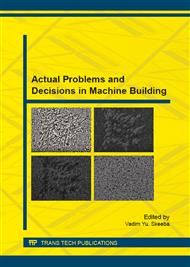p.11
p.17
p.22
p.28
p.35
p.41
p.46
p.52
p.58
Forecasting of Machined Surface Waviness on the Basis of Self-Oscillations Analysis
Abstract:
The paper states a problem of providing quality of geometrical characteristics of machined surfaces, which makes it necessary to forecast the occurrence and amount of oscillations appearing in the course of mechanical treatment. Objectives and tasks of the research are formulated. Sources of oscillation onset are defined: these are coordinate connections and nonlinear dependence of cutting force on the cutting velocity. A mathematical model of forecasting steady-state self-oscillations is investigated. The equation of the cutter tip motion is a system of two second-order nonlinear differential equations. The paper shows an algorithm describing a harmonic linearization method which allows for a significant reduction of the calculation time. In order to do that it is necessary to determine the amplitude of oscillations, frequency and a steady component of the first harmonic. Software which allows obtaining data on surface waviness parameters is described. The paper studies an example of the use of the developed model in semi-finished lathe machining of the shaft made from steel 40H which is a part of the BelAZ wheel electric actuator unit. Recommendations on eliminating self-oscillations in the process of shaft cutting and defect correction of the surface waviness are given.
Info:
Periodical:
Pages:
35-40
Citation:
Online since:
August 2015
Authors:
Price:
Сopyright:
© 2015 Trans Tech Publications Ltd. All Rights Reserved
Share:
Citation:


